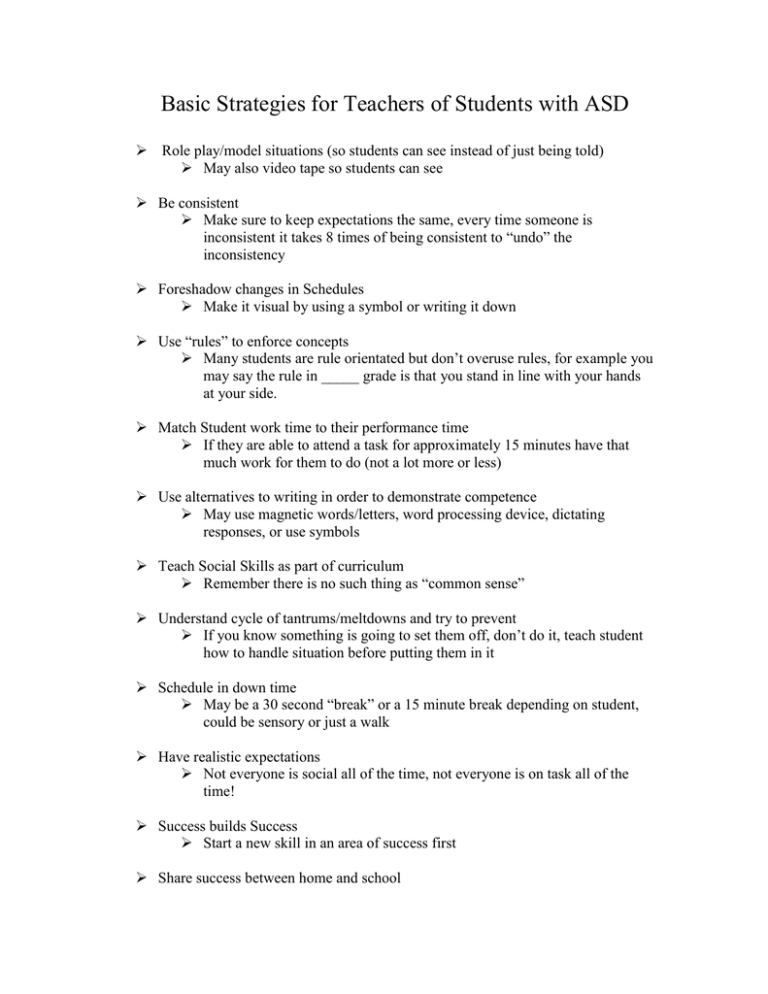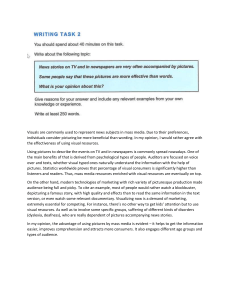Basic Strategies for Teachers of Students with ASD
advertisement

Basic Strategies for Teachers of Students with ASD Role play/model situations (so students can see instead of just being told) May also video tape so students can see Be consistent Make sure to keep expectations the same, every time someone is inconsistent it takes 8 times of being consistent to “undo” the inconsistency Foreshadow changes in Schedules Make it visual by using a symbol or writing it down Use “rules” to enforce concepts Many students are rule orientated but don’t overuse rules, for example you may say the rule in _____ grade is that you stand in line with your hands at your side. Match Student work time to their performance time If they are able to attend a task for approximately 15 minutes have that much work for them to do (not a lot more or less) Use alternatives to writing in order to demonstrate competence May use magnetic words/letters, word processing device, dictating responses, or use symbols Teach Social Skills as part of curriculum Remember there is no such thing as “common sense” Understand cycle of tantrums/meltdowns and try to prevent If you know something is going to set them off, don’t do it, teach student how to handle situation before putting them in it Schedule in down time May be a 30 second “break” or a 15 minute break depending on student, could be sensory or just a walk Have realistic expectations Not everyone is social all of the time, not everyone is on task all of the time! Success builds Success Start a new skill in an area of success first Share success between home and school Focus activities on turn taking/ self management Use visuals to assist (ex. Wait card) Pick a goal and focus on one for each activity Is the goal the academic content, independence, or socialization Maintain Structure Try to stay as consistent as possible with a routine Offer Choices when possible If two assignments need to be complete give student the choice of which one to do first Use a variety of stimuli in lessons Use visuals and hands on materials when possible Understand the function of a behavior Look for the reason behind the behavior, not just the behavior itself Use social stories, role playing, or videotaping to make abstract concepts concrete Try to think of picturing things in your mind or giving a definition of something, if you can’t you need to make it more concrete (ex. Showing what emotions look like, having a wait card, showing what “there” is) Teach in a variety of settings for generalization Introduce a new skill in a variety of places so that the student can see it applies to more than one setting Match visual supports with verbal instruction Example: hold up a math book when telling class to get out book, write page numbers on board Allow for “wait time” to receive a response Average processing time is 30-60 seconds, repeating won’t improve comprehension, you need to “wait” Use First/Then statements Example: First complete your math then it’s recess Autism is a reason, never an excuse Look for the function of a behavior and go from there! LESS IS MORE when it comes to verbal Even is a student is very verbal, talking too much creates anxiety and makes thing more difficult Stay Positive Reinke, 2014




